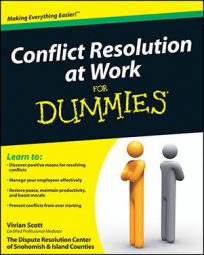In your role as facilitator for a large conflict-resolution discussion at work, be prepared, be present, and be ready to listen. Introduce yourself and describe your role as a facilitator. Explain how you’ll be assisting the group in the discussions and goals for the day. If you have guests or assistants, introduce them and describe their roles, as well.
Read the goal statement for the meeting. Ask for questions and allow time — five minutes at the most — for the participants to understand clearly the task for the day.
Present the agenda; finalize ground rules
Describe the details of what you’re asking of the group and the time frame for the meeting. Help the team understand what the large and small group goals are. Remember that your agenda should include time to ask questions and have a short discussion. The entire group must agree (a quick show of hands should do it) to all ground rules before you begin, because you’ll use the rules as your moral compass, so to speak, when things get heated or the meeting starts to derail.
Because you can’t be everywhere at once, create a version of the guidelines to post at small group stations to remind everyone of how they agreed to participate in this process.
Hear from the participants
It’s imperative to provide individuals with an opportunity to share their point of view. The goal in a large group setting is to do so in a way that has structure and isn’t a free-for-all. People can share their perspective in the large group or in smaller breakout groups, but take into account how intense the feelings may be and how vocal the group could get.
Provide a framework for people to follow when it’s their turn to speak so that they can acknowledge the past but quickly move to the future with solid ideas and a willingness to create something new.
Use intervention strategies
Members of a group often have differing expectations, assumptions, and needs. Some members need individual time and attention, and if they don’t get it, they may create interruptions. An important part of your job as facilitator is to handle such distractions with appropriate responses so you can move the discussion forward.
Moving around the room can curb disruptions before they occur. Maintaining eye contact with the group — not just the individual speaking — lets others know you care about what they’re thinking and feeling.
Break into small groups
Small group work requires focus; a group without focus will be unproductive and could end up creating a new conflict. Be sure that your instructions are clear and concise — everyone should know what your expectations are.
Small group work can include prioritizing a list generated by the larger group, finding weak spots in current systems, identifying potential snags in suggested solutions, or brainstorming on any number of issues.
Come back to the larger group
Each group needs a chance to share new insights and highlights. The process you choose depends on the goal for the meeting and the number of participants in attendance. If the group is large, you need someone to capture and record the ideas shared by the small group reporters.
The goal of coming back together is to get all the ideas in a central location, write them down on a whiteboard or flip chart, and then have the group decide which items are the most important.

